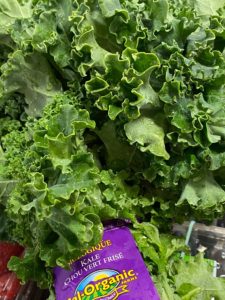
Move over, Popeye, and make room for kale!
A leafy green that continues to grow in popularity, kale is an amazing vegetable being recognized for exceptional nutritional value, health benefits and delicious flavor.
When we first opened our Bergenfield-based family business, Napolitano’s Produce, in the late 1950s, kale was a staple among vegetables, but most people who bought it were of European descent. Pop would leave the kale out to freeze a little before we sold it because he said it made it sweeter and more tender. We sold a lot of kale that way.
As the years went by, though, kale fell out of favor—until the 2000s, when increased interest in healthy eating put it back on everyone’s list. I’m no doctor, just a common-sense guy with a high school education and a thirst for knowledge, but I’ve always eaten plenty of green vegetables—and especially kale, considered the powerhouse of green vegetables because it’s high in antioxidants. These help build the immune system, lower cholesterol, repair damage done to our cells by chemicals, environmental pollutants and stress, and combat the aging process. I always say, “If you eat right, you’re going to live right,” and in that respect, kale is a great way to start the new year!
Packing a Nutritional Punch
Kale, also known as borecole, is one of the healthiest vegetables on the planet. A leafy green, kale is available in curly, ornamental or “dinosaur” varieties. It belongs to the Brassica family, which includes cruciferous vegetables such as cabbage, collard greens, broccoli and Brussels sprouts.
One cup of chopped kale contains only 33 calories and offers…
- 206 percent of our daily requirement of vitamin A
- 134 percent of our daily requirement of vitamin C
- A whopping 684 percent of our daily requirement for vitamin K, which helps our blood to clot
- Early 10 percent of our daily requirement for calcium

A rich source of antioxidants, vitamins A, C, and K, and a variety of beneficial minerals make kale one of the healthiest foods on the planet. Courtesy of Susan Bloom
It’s also a good source of healthy minerals such as copper, potassium, iron, manganese and phosphorus, as well as sulfur-containing phytonutrients. Kale is also rich in lutein and zeaxanthin, compounds that promote eye and vision health. All its benefits come through especially well when it’s eaten cooked instead of raw.
At the same time, kale can trigger issues for some people. For instance, anyone taking anticoagulants, such as Warfarin, may be advised to avoid kale because its high level of vitamin K could interfere with the drug. Kale also contains oxalates, naturally-occurring substances that can interfere with the absorption of calcium. To avoid problems, it helps to avoid eating calcium-rich foods like dairy at the same time as kale.
Varieties, Selection & Storage
Tuscan kale, also called dinosaur, Lacinato, or black kale and long used in Italian/Tuscan cuisine, isn’t as tough and fibrous as its curlier cousin, so it’s often served raw in salads. But as delicious as it is raw, it’s especially good cooked. Hearty, ridged and almost frilly in appearance, curly and red kale can be used interchangeably; the main difference between them is aesthetic.
Kale thrives in cooler-weather months, and its leaves range in color from dark green to purple to deep red. To find the freshest, look for firm, crisp, deeply-colored leaves with hardy stems. Smaller leaves will be more tender and milder in flavor. For best results, store kale unwashed in the refrigerator in an airtight, zipped plastic bag. It should keep for up to five days.
Preparation
Kale is delicious raw in salads, roasted to make chips or steamed. It’s great in shakes, where its somewhat bitter taste can be masked by other ingredients while boosting the shake’s nutritional value. Kids often hate green vegetables, but by adding kale to a shake with strawberries, bananas, blueberries, a little honey and some almond milk, for example, you can make something healthy for them without the harsh taste of straight kale. Be creative in your shakes, pair different seasonal fruits with healthy green vegetables, and I predict your children will love them!
A lot of people throw away the stems, but you don’t need to do that (I must get that trait from my mom, who never threw anything away). My wife, Bette, usually slices off some of the thicker stems, cuts up the rest very fine and adds them to the dish.
One of our household’s favorite ways to enjoy kale is sautéed with a little garlic and olive oil. Hope you’ll enjoy the following simple, tasty side dish. Wishing you a happy and healthy 2022!
Bette’s Simple Stir-Fried Kale
- 5 tablespoons olive oil
- 1 medium onion, diced
- 3 cloves garlic, minced
- 1 bunch kale, shredded
In a large frying pan, heat oil over medium-high heat. Add onions and garlic; cook and stir until softened. Stir in kale and cook until wilted. Serve hot or warm and enjoy!
About “Produce Pete” Napolitano
With over 65 years of experience in the produce industry, New Jersey’s own “Produce Pete” Napolitano is a renowned fruit and vegetable expert, author, and tv personality who’s appeared on a highly-popular segment on NBC’s Weekend Today in New York broadcast every Saturday mornings for over 28 years. For more information, visit www.producepete.com.
About Susan Bloom
A regular contributor to New Jersey Monthly and a variety of other well-known local and national publications, Susan Bloom is an award-winning New Jersey-based freelance writer who covers topics ranging from health and lifestyle to business, food, and more. She’s collaborated with Produce Pete on a broad range of articles for over a decade.



